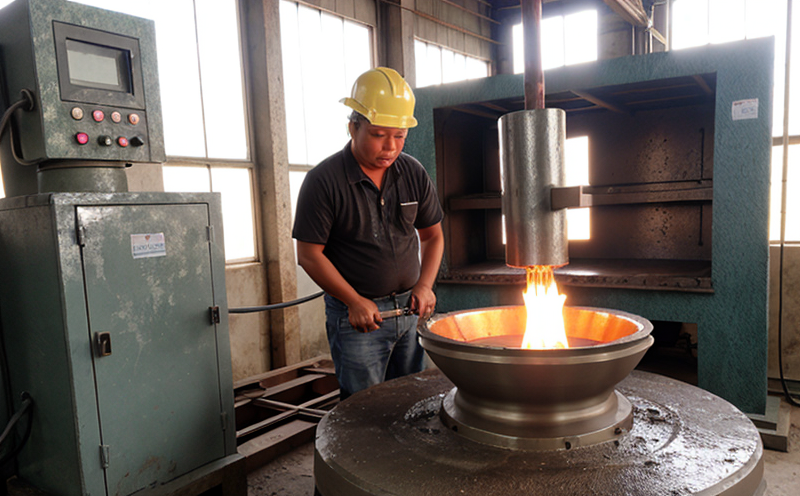ISO 4987 Steel Castings Penetrant Testing
The ISO 4987 standard specifies a non-destructive testing method known as penetrant testing (PT) for the examination of defects in ferrous castings. This type of testing is particularly useful in industrial manufacturing and processing, especially for sectors like automotive, aerospace, and defense, where high reliability and integrity are paramount.
Penetrant testing involves applying a liquid penetrant to the surface of the casting. The penetrant seeps into any open surface-breaking defects such as cracks or porosity. After a brief period, the excess penetrant is removed from the surface using a solvent. A developer is then applied to draw out the penetrant that has been absorbed by the defects, making them visible. This method allows for the detection of very small surface flaws and can be used on various types of ferrous castings.
The testing process requires strict adherence to the ISO 4987 standard to ensure reliable results. Specimen preparation is crucial; the casting must be clean, dry, and free from foreign materials that could interfere with the penetrant's performance. The penetrant should be applied evenly across the surface, following manufacturer recommendations for type, quantity, and dwell time.
The testing apparatus typically includes a range of tools such as spray equipment for applying penetrants and developers, as well as specialized lighting to enhance defect visibility. Reporting must comply with ISO standards, detailing the location, size, shape, and depth of any defects found. This information is vital for quality control processes and can influence subsequent manufacturing decisions.
Penetrant testing is advantageous because it is relatively inexpensive compared to other non-destructive methods like radiography or ultrasonic testing. It can be performed quickly on large areas of the casting, making it a cost-effective solution for initial defect screening. However, it has limitations; penetrant testing only detects surface-breaking defects and cannot determine their depth accurately.
Given its capabilities, ISO 4987 penetrant testing is widely used in various sectors where steel castings are critical components. For instance, aerospace engines rely heavily on castings for durability and performance, making penetrant testing a standard procedure to ensure safety and compliance with industry regulations.
The process requires careful preparation and interpretation of results by trained personnel familiar with ISO 4987 standards. Properly executed, it provides valuable insights into the integrity of steel castings, contributing significantly to product reliability and customer satisfaction. In summary, ISO 4987 penetrant testing is an indispensable tool in industrial manufacturing and processing, especially for sectors demanding stringent quality control.
Benefits
- Cost-Effective: Penetrant testing is less expensive than other non-destructive methods like radiography or ultrasonics.
- Rapid Screening: It can quickly screen large areas of castings for surface-breaking defects.
- Non-Destructive: The process does not damage the casting, allowing for multiple inspections if necessary.
- Visual Inspection: Defects are made visible using specialized lighting, providing clear visual evidence.
The use of penetrant testing can lead to significant cost savings by identifying and rectifying defects early in the manufacturing process. This proactive approach reduces the likelihood of costly rework or scrapped parts, enhancing overall efficiency. Additionally, it supports compliance with quality standards, thereby improving reputation among clients and stakeholders.
Why Choose This Test
- Comprehensive Coverage: Penetrant testing covers a wide surface area of castings efficiently, ensuring comprehensive defect detection.
- High Reliability: The method is highly reliable for identifying surface-breaking defects in ferrous castings.
- Standard Compliance: Adherence to ISO 4987 ensures that testing results are consistent and widely accepted across industries.
- Expertise Required: Trained personnel familiar with the standard can provide accurate interpretations of test results, enhancing reliability further.
Choosing penetrant testing based on ISO 4987 offers numerous advantages. The method’s ability to quickly and accurately identify surface-breaking defects enhances product quality and safety significantly. Additionally, compliance with international standards ensures that the testing process is recognized globally, facilitating smoother business operations across borders. Furthermore, the expertise involved in conducting this test guarantees reliable and accurate results, which are crucial for maintaining high-quality standards.
Customer Impact and Satisfaction
The implementation of ISO 4987 penetrant testing within industrial manufacturing processes has a profound impact on customer satisfaction. By ensuring that all steel castings meet stringent quality criteria, companies demonstrate their commitment to delivering superior products. This focus on quality not only enhances product reliability but also builds trust with customers.
Customers benefit from the peace of mind knowing that each casting undergoes thorough inspection before reaching them. This transparency fosters long-term relationships and repeat business as satisfied clients recommend your services to others. Moreover, adhering to international standards like ISO 4987 positions businesses favorably in competitive markets, further boosting customer satisfaction.
For quality managers and compliance officers, the use of penetrant testing ensures that all production meets required specifications. This aligns with broader corporate goals aimed at maintaining high-quality standards across operations. In turn, satisfied customers contribute to overall business success by contributing positively to brand reputation and growth.





